We made it back from Šiluva the night before and I think I can speak for everyone in saying that we had all enjoyed a hot shower and our night’s rest in the Hotel Congress. As the last full day in Lithuania, today’s date had been designated as a free day for students to roam the city and explore what they please. Since we left Vilnius for the countryside earlier than expected last week, we took the opportunity to finally have the tour of the old city. With the wonderful and knowledgeable Ruta as our guide, the area of the city which was previously the Jewish ghetto, Vilna, was explained in thoughtful detail and places we had read or heard about visualized before us. The ghetto was in operation from September 6, 1941 until September 23, 1943. There were 2 sections to the ghetto: the small part which housed ~11k and the large part which housed ~35k people. People living in the small part arrived at the ghetto on September 6 and by early October almost all had been sent to the murder site at Paneriai. It is estimated that more than 40 thousand Jews from Vilnius and its suburbs were imprisoned here and that almost all of them were murdered at Paneriai. The ghetto was liquidated in 1943. All the meanwhile, groups were trying to escape the ghetto to join the partisans who were living and working out in the forests. Groups who managed to leave were often besieged or betrayed and rumors would circle back to the camp that these people did not make it, thus lowering the inmates’ desires to escape.
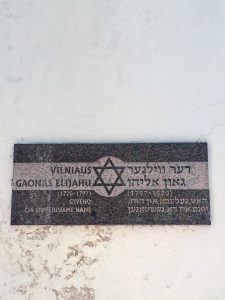
This plaque and the bust below commemorate the life and teachings of Vilniaus Gaonas Elijahu. Ganous translates to “genius” which is an accurate description of Vilniaus. He was a great rabbi of Vilnius and champion of technical text study. He is famous for his traditional ideas of Jewish intelligentsia, such as the intense study of the Talmud.

Professor Lieber remarked in front of the bust that the importance of Vilniaus to US visitors may seem “obscure, but there are actually many significant splits in Orthodox Judaism”. Americans understand orthodoxy as an example of the division in practice of Judaism, but are often unaware of the distinct branches within orthodoxy.
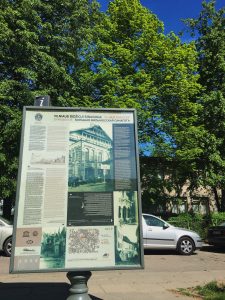
The Great Synagogue of Vilna was the oldest and most significant monument to Litvak Jewry. The construction of the building took place between 1633 and 1635 in Renaissance-Baroque style. A labyrinth like complex was formed around the synagogue and 12 other buildings, forming a prestigious center of Torah study and the spiritual home of Vilna Gaon. Despite the 20th century German destruction and consequent Soviet construction of a school over the site, 3 items of the Great Synagogue survived through WWII: a door of the Holy Ark, a reader’s desk, and a bas-relief with the Ten Commandments which are all now on display at the Vilna Gaon Museum.[1]
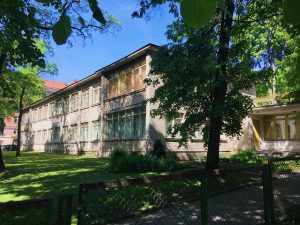
The building pictured here was a school built by the Soviets in 1950s. It was recently discovered by a team of archeologists that the Great Synagogue of Vilna lies below the foundation of this school. During WWII, Nazi bombing left the synagogue in great disrepair which eventually led to the Soviets’ decision to raze the building to the ground in the 1950s.
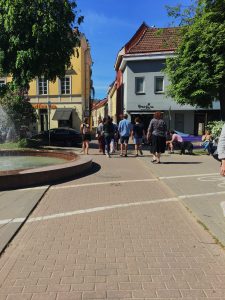
Pictured is the group walking along what used to be the Main Street of the Jewish ghetto during WWII. This area is now extremely cosmopolitan, with lanes of traffic of both sides of the median and upscale cafés and restaurants lining the streets.
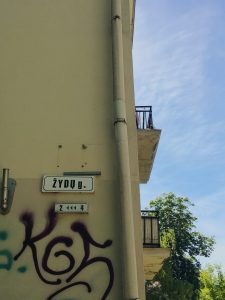
This street sign translates to “Jewish Street”, which marks the beginning of what used to be the main street through the Jewish ghetto.
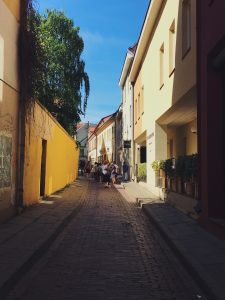
Group makes it deeper into the heart of what used to be the Jewish ghetto through the old Main St.
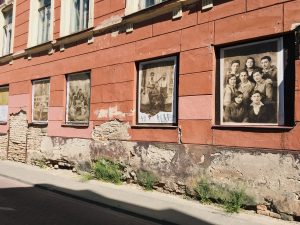
These photographs were found in the ruins of the Vilna ghetto.
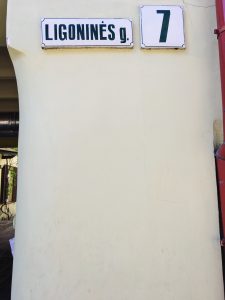
Translating to “Hospital Street”, this sign marks the road on which the hospital of the Vilna ghetto used to be located. Many of Vilnius’ current residents do not know the history behind the name of the street and question why it is named so.
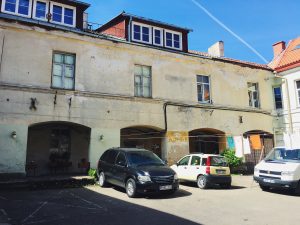
Pictured is the structure that used to house the hospital of the Vilna ghetto. Today, the building has been converted into apartments.
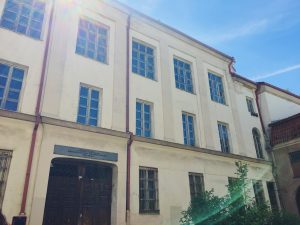
Here, we see the school of the old Jewish quarter of Vilnius. Ruta let us know that Fanya, the partisan we listened to who survived the Jewish ghetto and lives to share her stories, attended school here. Yiddish was a primary language taught here. The memorial plaque on the building reads that on November 3, 1941 200 Jews were selected for mass murderer by the Judenrat, Jacob Gents, who was not well liked for his cold demeanor and the luxuries his family enjoyed during the war.
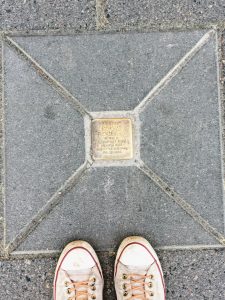
This plaque is in the sidewalk out front of the old school building. It commemorates Icchokas Rudaševskis who wrote a diary detailing the humiliation of not being able to fight the atrocities being committed against the Jewish people; the feeling of helplessness. He was murdered at Paneriai. There are 4 or 5 other similar squares across the city.
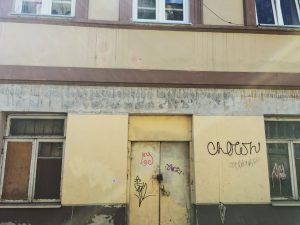
Words from the past fighting to shine through on a street from the ghetto…
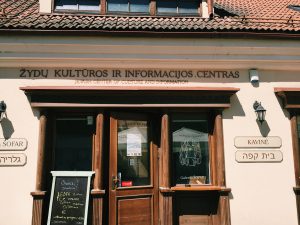
The future standing tall in the streets of Vilnius.
After parting ways with Ruta, students had a few hours to wander, shop, and eat. The group reconvened at 3PM for a gondola tour on the Neris river. This river snakes through Belarus and Lithuania, connecting Vilnius with the old capital Kernave. According to Lithuania’s travel page, the banks of this river house burial places of pagan Lithuanians, many mythological stones, and a sacred oak. [2] We concluded our day with dinner at Vegafé, a vegetarian restaurant highly recommended by Ruta. Here, we reflected as a group over our time in both Poland and Lithuania as well as brainstormed improvements for the class in the future. One of the more prominent themes we came up with would be increased involvement with the school children. We all felt that the period of time we spent talking at the school with the students was a hi light of the trip. It was also agreed that interaction with the community, whether it be the schoolchildren and their teachers or the townspeople as a whole, plays a crucial element in the experience of the trip and class.
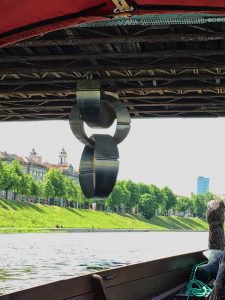
Some of the modern art that has been incorporated onto or below bridges that cross the Neris River.
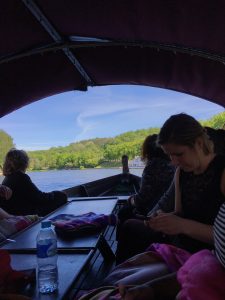
View from inside the gondola
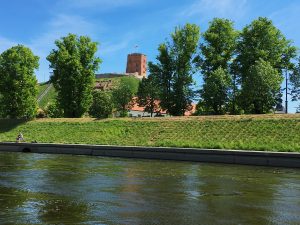
A view of the remains of the Upper Castle, once a part of the Vilnius Castle Complex, from the Neris River.
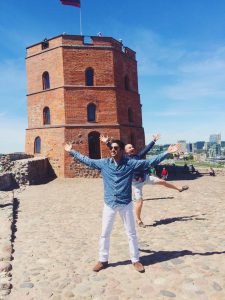
Sean having a photo shoot on the Upper Castle remains.
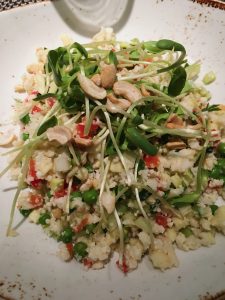
A cauliflower couscous salad from the restaurant Vegafé we ate at on the last night.
